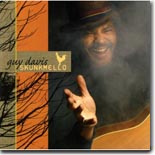|
Guy Davis
Skunkmello
Red House
|

Guy Davis is the son of well-known actors Ruby Dee and Ossie
Davis. Raised in New York, his overlapping interest in music and acting
surely enabled his destiny to blues of the rural south. After doing TV
soap operas he then combined music and acting, appearing Off-Broadway as
legendary Robert Johnson. At this point French TV asked Davis to travel
to Mississippi to film a documentary about Johnson. Davis says that
emotional experience gave him a connection between the blues and slavery
that made him not only a student of the blues, but gave him permission
to compose. Somewhere in the ‘90s, Guy Davis then wrote and performed
his one-man show “In Bed with the Blues: Adventures of Fishy Waters,”
where this reviewer first heard him.
Released April 4, 2006 on the Red House label, Skunkmello is the
eighth album by Guy Davis (label founder Bob Feldman died 1-11-06 and
receives dedication within). To paraphrase the album’s liner notes, some
lies tell the truth, great liars include authors, and some storytellers’
fictions aren’t necessarily lies. Skunkmello, if you believe a
self-proclaimed liar, was a chicken thief who was caught and hanged
around 1900.
The music reeks of a current-day country blues style, not unlike Taj
Mahal, who it turns out was an early influence of, and mentor to, Davis.
The album’s instrumentation is delightfully minimal, all-acoustic
(except for organ), and full of feeling, warmth, and interest. Davis has
a very individual vocal, obviously playing his own harmonica. Initial
listening suggests he plays most of the stringed instruments too (the
credits confirm this), but there are additional mandolin, acoustic and
electric guitar and banjo players. Accordion also adds to, rather than
detracts from, an eventual swamp feeling.
The musicians have combined experience with people like Paul
Butterfield, Van Morrison and the Saturday Night Live Band. Davis
himself learned banjo at age eight from Pete Seeger, and has developed a
style of both finger-picking and the use of slide on the 12-string
guitar (pointing out that Willie McTell and Leo Kottke are among the
rare few who have utilized this combination).
The CD contains 11originals and three covers. The often-performed “Goin’
Down Slow” here is my new favorite version and is dedicated to some
recent late-greats: Ray Charles, Gatemouth Brown, Oscar Brown Jr., R.L.
Burnside and Raful Neal. The inspiration of Davis’ “Chocolate Man” is
obviously Mississippi John Hurt’s “Candy Man,” then Howlin’ Wolf and
John Lee Hooker are echoed within a single track.
On the heartfelt “Blues In The Midnight Hour,” Davis deeply exclaims “No
one knows my heartache…,” but I think we just may, if only because of
the emotion achieved. “Hooking Bull At The Landing” identifies feelings
of close parental ties and is indeed authored in part by Davis’ late
father (the bull is a policeman, the hook is what he uses, and the
landing is where the boxcar stopped).
Thematically, other tracks cover double-entendre, relationships and
family, plus added treats like a chicken dance and proof that old-school
Blues IS where Rap came from. This is the last track called “Uncle Tom
Is Dead” (the “milk ‘n’ cookies” remix) with the original
radio-unfriendly lyrics creatively blanked, relegating our imaginations
back to work. The unedited version appeared on an earlier Davis album
and in both cases Guy’s teenage son Martial is the other voice,
representing Hip Hop.
What we really have here in still-young Guy Davis is nurtured
spirituality, and wisdom earned from courage and seasoned experience. A
grade of A+ especially for representing deep-rooted quality for our
times. For more:
www.redhouserecords.com or
www.guydavis.com.
---Tom Coulson
Radio broadcaster/musician
comments to tcoulson@ktar.com